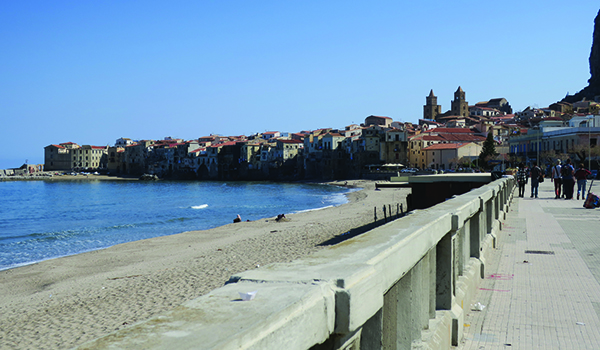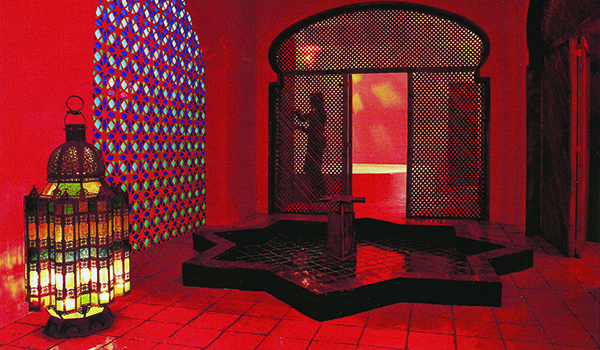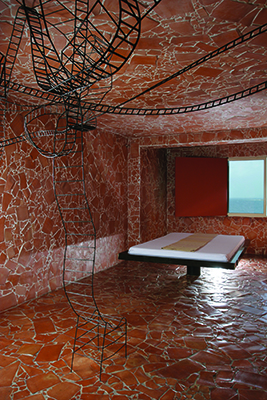Spring is an ideal time for visiting Sicily. The town of Cefalù on the northern coast is particularly charming before the temperature soars and the hoards descend. Lorenza Bacino and her family enjoyed the April sunshine exploring this delightful town and the nearby Madonie Regional Park.
A few hardy northern European visitors braved the calm, clear waters, but most locals preferred to keep their clothes on despite the mild weather.
Upon reaching our destination of Lascari, a village on the edge of the Madonie Regional Park, a short drive from Cefalù, the grumpy mood in the car began to lift. Our flight from London to Palermo had been ridiculously early. Yet upon entering our modern, light, spacious villa gasps of delight from the children reassured me that all was forgiven.
The views from the two enormous corner windows – the shimmering sea in the distance on one side and the rugged Madonie cliffs on the other, were sensational. The patio and swimming pool area provided a perfect spot for enjoying an aperitif at sunset and the very decent wi-fi was much appreciated, especially by the two youngsters. Enticing them away from our temporary home wasn’t easy, but here are some of the things we found to see and do during our week-long stay…

Cefalù and its Rock (La Rocca)
The winding cobbled streets, impressive Norman Duomo and layers of history make Cefalù a fascinating little town. Intersperse the cultural exploits with traditional Sicilian delicacies such as arancini (rice balls stuffed with meat and mozzarella), sweet ricotta pastries and the famed pistacchio ice-cream, and you’ll surely find it a real winner as a family-friendly destination.
The town as it stands today was built at the behest of the Norman king Roger II and construction of the unique Sicilian Romanesque cathedral began in 1131. Nestled in the apse is a beautiful golden Byzantine mosaic of Christ called Christ Pantocrator, or Almighty. Two massive Norman towers on either side of the façade stand four storeys high and dominate the rooftops of the old town.
My 11-year-old was far more interested in the café life unfolding on the piazza at the foot of the Duomo and enjoyed her first arancino on the steps. It was a slippery slope from here on as we were forced to seek out these tasty morsels on a daily basis.

Exploring the little alleyways, we learned to dodge the odd crazy Vespa hurtling by and the archway leading through to Cefalù’s beach gave us a new perspective on the town. We discovered the Lavatoio Medievale at the foot of a winding staircase where small pools of fresh water fill up and where women used to come and wash their family’s clothes all those centuries ago. It’s a curious and unexpected landmark carved out of a smooth local stone known as lumachella.

The centrally located Museo Mandralisca (www.fondazionemandralisca.it) is a small privately owned museum where you can see Renaissance painter Antonello da Messina’s famed Portrait of an Unknown Man (1465). The portrait is very small and very beautiful, tucked away at the far end behind a screen. The smile reminded me of Leonardo’s Mona Lisa. Baron Mandralisca amassed his collection of archaeological treasures, stuffed animals, paintings and furniture in the 19th century and the tiled floor and the library are gorgeous. It’s an intimate family collection and we really enjoyed our visit, especially as children are invited to draw a picture which is then added to the other exhibits.
A hike up ‘La Rocca’ to the ruins of the 4th-century Temple of Diana and the ancient remains of the Saracen fortification is a must. It’s quite a challenging 40-minute climb but the views from the top of this granite mound are spectacular. The children bounded up like goats and disappeared among the ruins, scrambling up ancient walls eagerly seeking out the best vantage points.
Cooking from the heart
MassimoVillas organised a cooking morning with Nino Quartana, artist and chef, especially for my daughter, who loves to bake. Nino’s modern villa is set in the hills above Cefalù and we whiled away a wonderful few hours learning about the herbs and spices in his ‘synergetic’ organic garden, picking green apples and edible flowers for an upsidedown apple cake and picking up lots of useful cooking tips along the way.
The atmosphere chez Nino is a fusion of Eastern and Mediterranean influences combining art, design and cookery. “Non si butta niente,” he says – nothing is wasted. My daughter learned to caramelise apples using Nino’s organic orange marmalade; she learned that dampening the greaseproof paper and screwing it up before smoothing it onto the surface of the pastry lends it a marble-like appearance, and that rolling it out under greaseproof paper prevents it cracking and crumbling. She also learned how to make her own pastry from scratch.
Whilst the upside-down apple cake was in the oven, she prepared a simple pasta dish, spaghetti with aglio, olio e peperoncino (garlic, oil and chilli) and all of the above was eaten sitting on Nino’s patio listening to colourful local stories in the gentle breeze on the hillside. It was, in all, a thoroughly enjoyable and informative experience.
Chef Nino
Nino Quartana will come to your villa as personal chef and cook for you and your friends, or you can learn to cook with him. It’s a wonderful experience as Nino cooks from the heart and has been doing so since the age of eight. See www.ninoquartana.com for more on art and his Facebook page, Chef Nino, for details on cookery.
Contact: +39 347 023 9223 or email him at ninoquartana@hotmail.com
Fiumara d’Arte and the Atelier sul Mare
If you are interested in modern art, you’ll find the Art Hotel and Fiumara Sculpture Park in Castel di Tusa – a 40-minute drive along the coast towards Messina – a magical experience. Contemporary international artists have transformed 24 of the rooms at the Atelier sul Mare into living artworks each revealing an intriguing back story.

The guided tour is a journey in itself where the ideas behind the design of each room slowly unravel. They are all fascinating. Don’t imagine you’ll be entering through a standard door: maybe you’ll be feeling your way down a darkened corridor which suddenly opens into a light-filled room with a sea-view, or you’ll walk down a bronze gangplank into the unknown and marvel at how each space has been transformed into a work of art.

Antonio Presti is the artist and the brain behind the Art Hotel which began after the death of his father back in 1982. Presti wanted to create a monument to his father’s memory, but he was also a passionate believer in art for the people.
After the room tour, pick up a map from reception and see how many sculptures you can find within a 50km radius in the Fiumara Park, Europe’s largest open-air museum. There are ten in total, and they’re absolutely huge.
We found the steel Pyramid built on the 38th Parallel at the top of a hill, and the bright blue concrete wave, or Energia Mediterranea, on a grass verge at the end of a narrow road. You can climb on them, touch them, feel them or just gaze up at them.
Again, created by different contemporary artists, it has taken Presti more than two decades to achieve recognition for his open-air museum and he’s had to overcome more than a few political obstacles along the way. By refusing to succumb to regional pressures and threats, Presti has shown how art can triumph over politics and his creation at Fiumara di Tusa is a remarkable treasure trove of great international significance.
Find out more on this amazing story at www.atelierssulmare.it.
The Centro Internazionale per le Scienze Astronomiche
Above the tiny picturesque village of Isnello sits the Centro Internazionale per le Scienze Astronomiche – or Gal Hassin International Astronomy Centre – like a mini-Greenwich. There’s a 10-metre diameter planetarium replete with 12 telescopes on the observation terrace and an interactive multimedia exhibition space. We were astounded to find an international astronomy research station in the middle of nowhere and couldn’t resist a visit.
My son (aged 14) and I enjoyed learning about time and how it is calculated on a guided tour of the surrounding park with its sundials of varying shapes and sizes. Do book ahead as the Astronomy Centre is not open to visitors all the time.
See www.galhassin.it to make a reservation to visit.
Castelbuono and Gratteri
Other villages within the Madonie Park include Castelbuono, a quaint medieval village where you’ll eat the best panettone ever. It’s light, fluffy and utterly divine. Varieties are distributed to visitors in the main square and you can choose a favourite to buy and take home from the nearby Fiasconara shop.
The family has been making their delicious recipes since the 1950s when Mario Fiasconara opened a small ice-cream parlour in the village. By the 1990s the Fiasconara brand had become international and continues to grow to this day. See www.fiasconaro.com for more on the Fiasconara family story.
Gratteri derives its name from the Greek word for basin, or crater. It used to be a fortress town for the Byzantines and the Moors; the present town is built on the site of a river, indicating its transition from a military to a commercial centre. It was developed by the Lords Ventimiglia, whose graves you can visit. Also worth seeing is the Church of Santa Maria del Gesù.
